Homelite UT10532 OPERATORS MANUAL
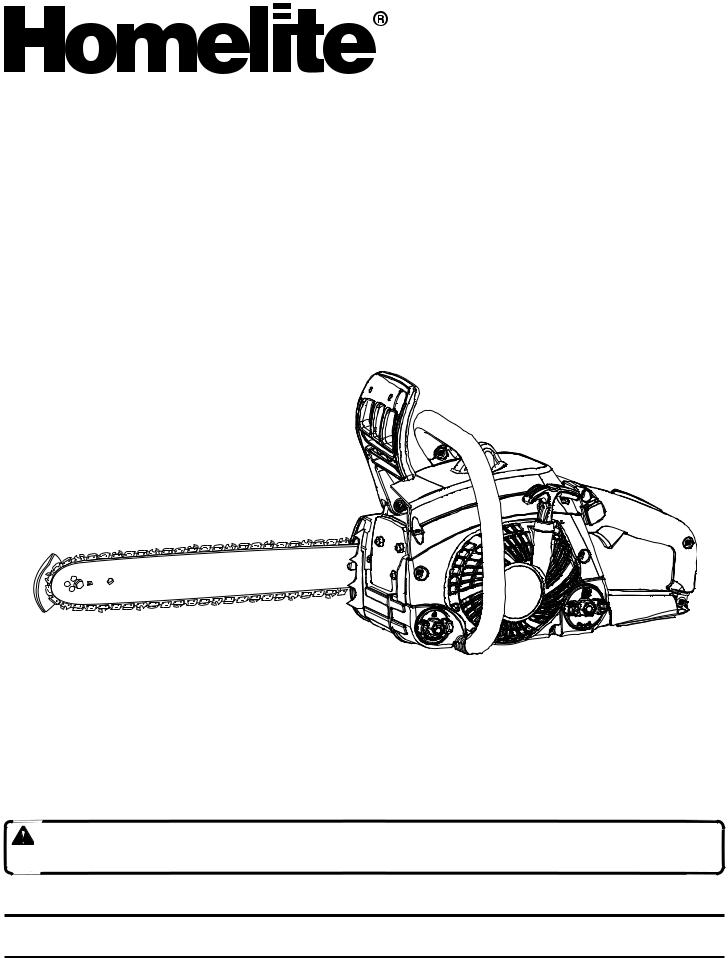
OPERATOR’S MANUAL
16 in. 33cc CHAIN SAW
UT10532
Your chain saw has been engineered and manufactured to Homelite’s high standard for dependability, ease of operation, and operator safety. When properly cared for, it will give you years of rugged, trouble-free performance.
WARNING: To reduce the risk of injury, the user must read and understand the operator’s manual before using this product.
Thank you for buying a Homelite product.
SAVE THIS MANUAL FOR FUTURE REFERENCE
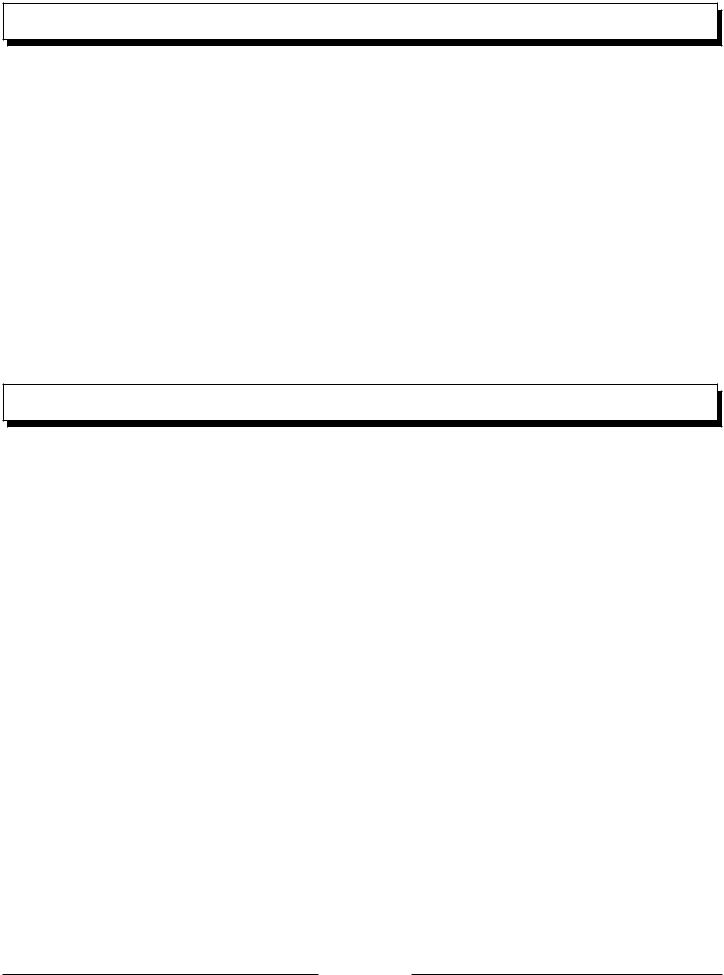
|
TABLE OF CONTENTS |
Introduction ..................................................................................................................................................................... |
2 |
General Safety Rules.................................................................................................................................................... |
3-4 |
Specific Safety Rules....................................................................................................................................................... |
4 |
Symbols........................................................................................................................................................................ |
5-6 |
Glossary of Terms............................................................................................................................................................ |
7 |
Features........................................................................................................................................................................ |
8-9 |
Assembly ......................................................................................................................................................................... |
9 |
Operation.................................................................................................................................................................. |
10-20 |
Maintenance............................................................................................................................................................. |
21-31 |
Bar and Chain Combinations ........................................................................................................................................ |
32 |
Troubleshooting........................................................................................................................................................ |
32-33 |
Warranty ................................................................................................................................................................... |
34-36 |
Parts Ordering / Service ................................................................................................................................................ |
38 |
|
INTRODUCTION |
This product has many features for making its use more pleasant and enjoyable. Safety, performance, and dependability have been given top priority in the design of this product making it easy to maintain and operate.
Page 2

GENERAL SAFETY RULES
WARNING:
Read and understand all instructions. Failure to follow all instructions listed below, may result in electric shock, fire and/or serious personal injury.
READ ALL INSTRUCTIONS
Know your tool. Read the operator’s manual carefully. Learn the saw’s applications and limitations as well as the specific potential hazards related to this tool.
Kickback may occur when the nose or tip of the guide bar touches an object, or when the wood closes in and pinches the saw chain in the cut. Tip contact in some cases may cause a lightning-fast reverse reaction, kicking the guide bar up and back toward the operator. Pinching the saw chain along the top of the guide bar may push the guide bar rapidly back toward the operator. Either of these reactions may cause you to lose control of the saw, which could result in serious personal injury. Do not rely exclusively upon the safety devices built into the saw. As a chain saw user, you should take several steps to keep your cutting jobs free from accident or injury.
•With a basic understanding of kickback, you can reduce or eliminate the element of surprise. Sudden surprise contributes to accidents.
•Keep a good firm grip on the saw with both hands when the engine is running. Place your right hand on the rear handle and your left hand on the front handle with your thumbs and fingers encircling the chain saw handles. A firm grip together with a stiff left arm will help you maintain control of the saw if kickback occurs.
•Make sure that the area in which you are cutting is free from obstructions. DO NOT let the nose of the guide bar contact a log, branch, fence, or any other obstruction that could be hit while you are operating the saw.
•Cut at high engine speeds. Always cut with the engine running at full speed. Fully squeeze the throttle trigger and maintain a steady cutting speed.
•Do not overreach or cut above chest height.
•Follow the manufacturer’s sharpening and maintenance instructions for the saw chain.
•Only use replacement bars and chains specified by the manufacturer or the equivalent.
Do not operate a chain saw with one hand. Serious injury to the operator, helpers, bystanders, or any combination of these persons may result from one-handed operation. A chain saw is intended for two-handed use.
Do not operate a chain saw when you are fatigued.
Fatigue causes carelessness. Be more cautious before rest periods and towards the end of your shift. Never operate a chain saw when you are tired or under the influence of medication, drugs, or alcohol.
Use safety footwear. Wear snug-fitting clothing,
protective gloves, and eye, hearing, and head protection devices.
Do not stand on any unstable surface while using the chain saw, that includes ladders, scaffolds, trees, etc.
Use caution when handling fuel. Move the chain saw at least 30 feet from the fueling point before starting the engine.
Do not allow other persons to be near the chain saw when starting or cutting with the chain saw. Keep bystanders and animals out of the work area.
Do not start cutting until you have a clear work area, secure footing, and a planned retreat path from the falling tree.
Keep all parts of your body away from the saw chain when the engine is running.
Always carry the chain saw with the engine stopped and the brake engaged, the guide bar and saw chain to the rear, and the muffler away from your body. When transporting the chain saw, use the appropriate guide bar scabbard.
Do not operate a chain saw that is damaged, improperly adjusted, or not completely and securely assembled. Be sure that the saw chain stops moving when the throttle control trigger is released.
Shut off the engine before setting the chain saw down. Do not leave the engine running unattended. As an additional safety precaution, apply the chain brake prior to setting down the saw.
Use extreme caution when cutting small-size brush and saplings because slender material may catch the saw chain and be whipped toward you or pull you off balance.
When cutting a limb that is under tension, be alert for springback so that you will not be struck when the tension in the wood fibers is released.
Keep the handles dry, clean, and free of oil or fuel mixture.
Beware of carbon monoxide poisoning. Operate the chain saw only in well-ventilated areas.
Do not operate a chain saw in a tree unless you have been specifically trained to do so.
Do not cut from a ladder; this is extremely dangerous.
All chain saw service, other than the items listed in the instruction manual and all maintenance, should be performed by competent chain saw service personnel. (For example, if improper tools are used to remove the flywheel or if an improper tool is used to hold the flywheel in order to remove the clutch, structural damage to the flywheel could occur and subsequently could cause the flywheel to burst.)
Always have a fire extinguisher available when using chain saw.
Use only the replacement guide bars and low kickback chains specified for the saw.
Page 3
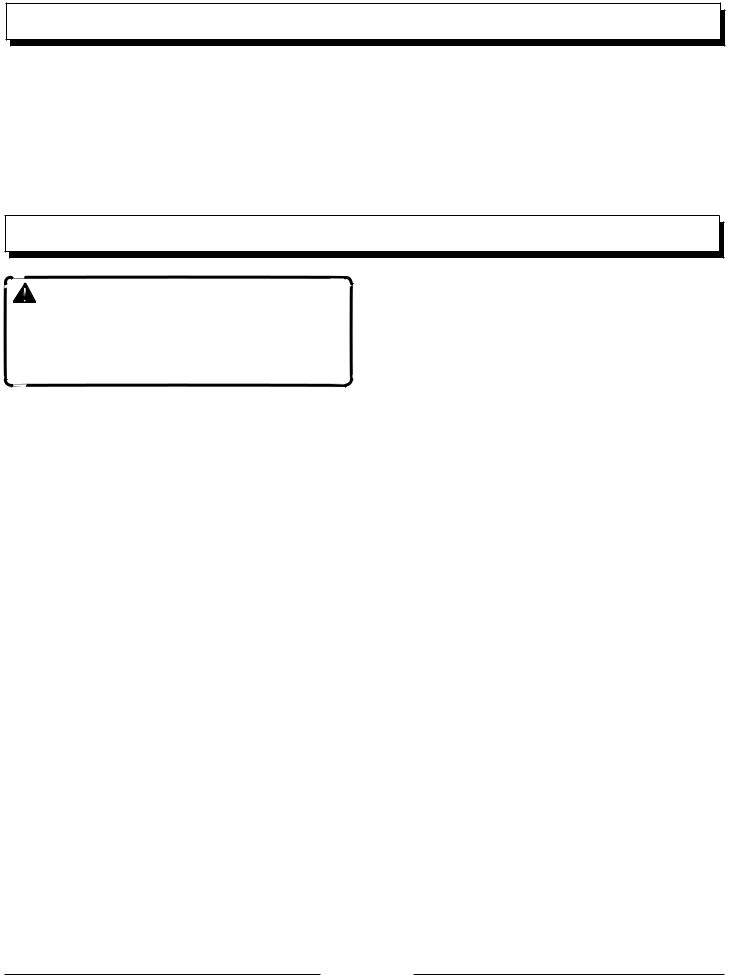
GENERAL SAFETY RULES
Do not adapt the powerhead to a bow guide or use it to power any attachments or devices not listed for the saw.
The gas powered saw (or electrically powered saw) is classified by CSA as a Class 1C (or Class 2C) saw.
It is intended for infrequent use by homeowners, cottagers, and campers, and for such general applications as clearing, pruning, cutting firewood, etc. It is not intended
for prolonged use. Prolonged periods of operation can cause circulatory problems in the user’s hands due to vibration. For such use, it may be appropriate to use a saw having an anti-vibration feature.
Save these instructions. Refer to them frequently and use to instruct other users. If you loan someone this tool, loan them these instructions also.
SPECIFIC SAFETY RULES
WARNING:
The warnings, labels, and instructions found in this section of the operator’s manual are for your safety. Failure to follow all instructions may result in serious personal injury.
Do not cut vines and/or small underbrush (a diameter of less than 3 in.).
Muffler surfaces are very hot during and after operation of the chain saw; keep all body parts away from the muffler. Serious burns may occur if contact is made with the muffler.
Always hold the chain saw with both hands when the engine is running. Use a firm grip with thumbs and fingers encircling the chain saw handles.
Never let anyone use the chain saw who has not received adequate instructions in its proper use. This applies to rentals as well as privately owned saws.
Before you start the engine, make sure the saw chain is not contacting any object.
Wear snug-fitting clothing. Always wear heavy, long pants, boots, and gloves. Do not wear jewelry, short pants, sandals, or go barefoot. Do not wear loose fitting clothing, which could be drawn into the engine or catch the chain or underbrush. Wear overalls, jeans, or chaps made of cut-resistant material or ones that contain cutresistant inserts. Secure hair so that it is above shoulder level.
Wear non-slip safety footwear and heavy-duty gloves to improve your grip and to protect your hands.
Wear eye protection which is marked to comply with ANSI Z87.1, as well as hearing and head protection, when operating this equipment.
Keep bystanders and animals out of the work area.
Do not allow other persons to be nearby during starting or cutting with the chain saw.
NOTE: The size of the work area depends on the job being performed as well as the size tree or workpiece involved. For example, felling a tree requires a larger work area than making other cuts (i.e., bucking cuts, etc.).
Keep SAFE-T-TIP anti-kickback nose guard properly mounted on the guide bar to prevent rotational kickback.
Follow the sharpening and maintenance instructions for the saw chain.
Never operate a chain saw that is damaged, improperly adjusted, or is not completely and securely assembled. Be sure that the saw chain stops moving when the throttle control trigger is released. If the saw chain moves at idle speed, the carburetor may need adjusting. Refer to Adjusting the Carburetor in the Maintenance section of this manual. If the saw chain still moves at idle speed after adjustment has been made, contact an authorized service center for adjustment and discontinue use until the repair is made.
REFUELING (DO NOT SMOKE!)
To reduce the risk of fire and burn injury, handle fuel with care. It is highly flammable.
Mix and store fuel in a container approved for gasoline.
Mix fuel outdoors where there are no sparks or flames.
Select bare ground, stop the engine, and allow it to cool before refueling.
Loosen the fuel cap slowly to release pressure and to keep fuel from escaping around the cap.
Tighten the fuel cap securely after refueling.
Wipe spilled fuel from the unit. Move 30 feet away from refueling site before starting engine.
Never attempt to burn off spilled fuel under any circumstances.
KICKBACK
Kickback is a dangerous reaction that can lead to serious injury. Do not rely only on the safety devices provided with the saw. As a chain saw user, you must take special safety precautions to help keep your cutting jobs free from accident or injury. See the General Safety Rules and Operation sections of this manual for added information on kickback and how to avoid serious personal injury.
Page 4
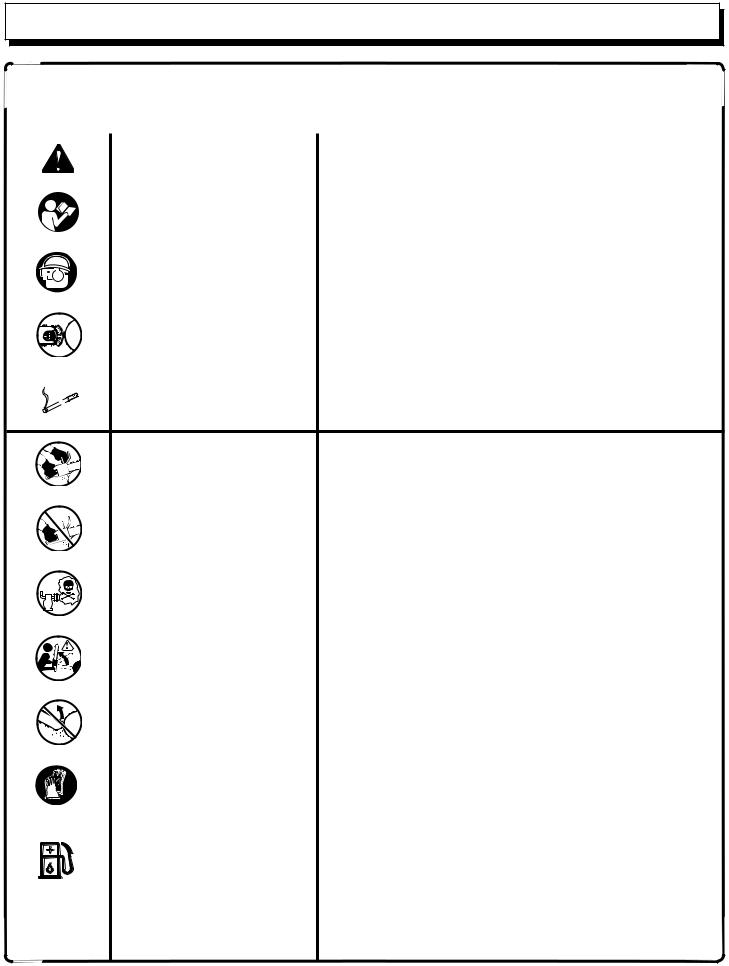
SYMBOLS
Some of the following symbols may be used on this tool. Please study them and learn their meaning. Proper interpretation of these symbols will allow you to operate the tool better and safer.
|
SYMBOL |
NAME |
DESIGNATION/EXPLANATION |
||
|
|
|
|
Safety Alert |
Precautions that involve your safety. |
|
|
|
|
|
|
|
|
|
|
Read The Operator’s Manual |
To reduce the risk of injury, user must read and understand |
|
|
|
|
operator’s manual before using this product. |
|
|
|
|
|
|
|
|
|
|
|
|
|
|
|
|
|
Wear Eye, Hearing, and Head |
Wear eye protection which is marked to comply with ANSI Z87.1 |
|
|
|
|
as well as hearing and head protection when operating this |
|
|
|
|
|
Protection |
|
|
|
|
|
equipment. |
|
|
|
|
|
|
|
|
|
|
|
|
|
|
|
|
|
SAFE-T-TIP Nose Guard |
The SAFE-T-TIP nose guard on the guide bar helps prevent |
|
|
|
|
kickback. |
|
|
|
|
|
|
|
|
|
|
|
|
|
|
|
|
|
No Smoking |
No smoking, sparks, or open flame. |
|
|
|
|
||
|
|
|
|
|
|
|
Operate With Two Hands |
Hold and operate the saw properly with both hands. |
|
|
|
|
|
|
One Handed |
Do not operate the saw using only one hand. |
|
|
|
|
|
|
Carbon Monoxide |
Engines produce carbon monoxide which is an odorless, deadly |
|
|
poison. Do not operate in an enclosed area. |
||
|
|
||
|
|
|
|
|
Kickback |
DANGER! Beware of kickback. |
|
|
|
|
|
|
Bar Nose Contact |
Avoid bar nose contact. |
|
|
|
|
|
|
Wear Gloves |
Wear non-slip, heavy-duty protective gloves when handling the |
|
|
chain saw. |
||
|
|
||
|
|
|
|
|
|
Use unleaded gasoline intended for motor vehicle use with an |
|
|
Gasoline and Oil |
octane rating of 87 [(R + M)/2] or higher. This product is powered |
|
|
by a 2-cycle engine and requires pre-mixing gasoline and 2-cycle |
||
|
|
||
|
|
oil. |
|
|
|
|
|
|
Keep Bystanders Away |
Keep all bystanders and animals at least 50 ft. away. |
|
|
|
Page 5 |
|
|
|
|
|
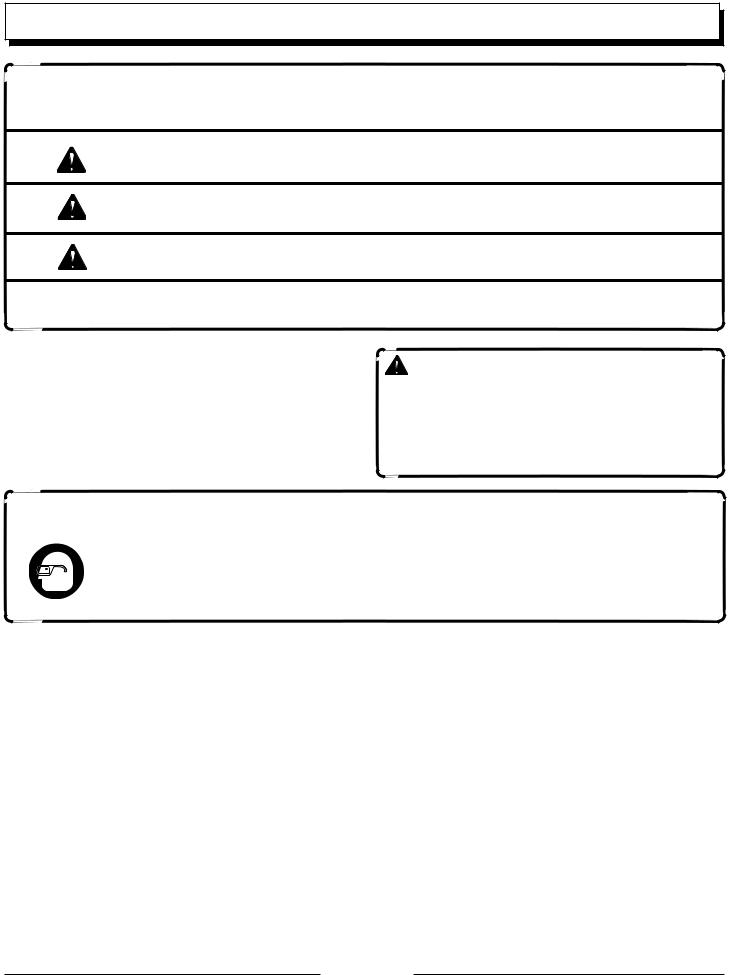
SYMBOLS
The following signal words and meanings are intended to explain the levels of risk associated with this product.
SYMBOL SIGNAL |
MEANING |
DANGER: Indicates an imminently hazardous situation, which, if not avoided, will result in death or serious injury.
WARNING: Indicates a potentially hazardous situation, which, if not avoided, could result in death or serious injury.
CAUTION: Indicates a potentially hazardous situation, which, if not avoided, may result in minor or moderate injury.
CAUTION: (Without Safety Alert Symbol) Indicates a situation that may result in property damage.
SERVICE
Servicing requires extreme care and knowledge and should |
WARNING: |
|
be performed only by a qualified service technician. For |
To avoid serious personal injury, do not attempt to use |
|
service we suggest you return the product to your nearest |
||
this product until you read thoroughly and understand |
||
AUTHORIZEDSERVICECENTER forrepair.When servicing, |
||
completely the operator’s manual. Save this operator’s |
||
use only identical replacement parts. |
||
manual and review frequently for continuing safe operation |
||
|
||
|
and instructing others who may use this product. |
 WARNING:
WARNING:
The operation of any power tool can result in foreign objects being thrown into your eyes, which can result in severe eye damage. Before beginning power tool operation, always wear safety goggles, safety glasses with side shields, or a full face shield when needed. We recommend Wide Vision Safety Mask for use over eyeglasses or standard safety glasses with side shields. Always use eye protection which is marked to comply with ANSI Z87.1.
SAVE THESE INSTRUCTIONS
Page 6

GLOSSARY OF TERMS
Bar Tip Guard
An attachment that may be provided on the end of the guide bar to prevent the chain at the end of the guide bar from contacting the wood.
Bucking
The process of cross cutting a felled tree or log into lengths.
Chain Brake
A device used to stop the saw chain.
Chain Saw Powerhead
A chain saw without the saw chain and guide bar.
Clutch
A mechanism for connecting and disconnecting a driven member to and from a rotating source of power.
Drive Sprocket or Sprocket
The toothed part that drives the saw chain.
Felling
The process of cutting down a tree.
Felling Back Cut
The final cut in a tree felling operation made on the opposite side of the tree from the notching undercut.
Front Handle
The support handle located at or toward the front of the chain saw. This handle is for the left hand.
Front Handle Guard
A structural barrier between the front handle of a chain saw and the guide bar, typically located close to the hand position on the front handle, and sometimes employed as an activating lever for a chain brake.
Guide Bar
A solid railed structure that supports and guides the saw chain.
Kickback
The backward or upward motion, or both, of the guide bar occurring when the saw chain near the nose of the top area of the guide bar contacts any object such as a log or branch, or when the wood closes in and pinches the saw chain in the cut.
Kickback (Pinch)
The rapid pushback of the saw which can occur when the wood closes in and pinches the moving saw chain in the cut along the top of the guide bar.
Kickback (Rotational)
The rapid upward and backward motion of the saw which can occur when the moving saw chain near the upper portion of the tip of the guide bar contacts an object, such as a log or branch.
Low-Kickback Chain
A chain that complies with the kickback performance requirements of ANSI B175.1 when tested on a representative sample of chain saws.
Normal Cutting Position
Those positions assumed in performing the bucking and felling cuts.
Notching Undercut
A notch cut in a tree that directs the tree’s fall.
Rear Handle
The support handle located at or toward the rear of the saw. It normally contains the throttle. This handle is for the right hand.
Reduced Kickback Guide Bar
A guide bar which has been demonstrated to reduce kickback significantly.
Replacement Saw Chain
A chain that complies with the kickback performance requirements of ANSI B175.1 when tested with specific chain saws. It may not meet the ANSI performance requirements when used with other saws.
Saw Chain
A loop of chain having cutting teeth that cut the wood, and that is driven by the motor and is supported by the guide bar.
Springpole
A small tree (sapling) or limb that is bent or trapped under tension. It may “spring back” rapidly when cut, causing a dangerous situation.
Page 7
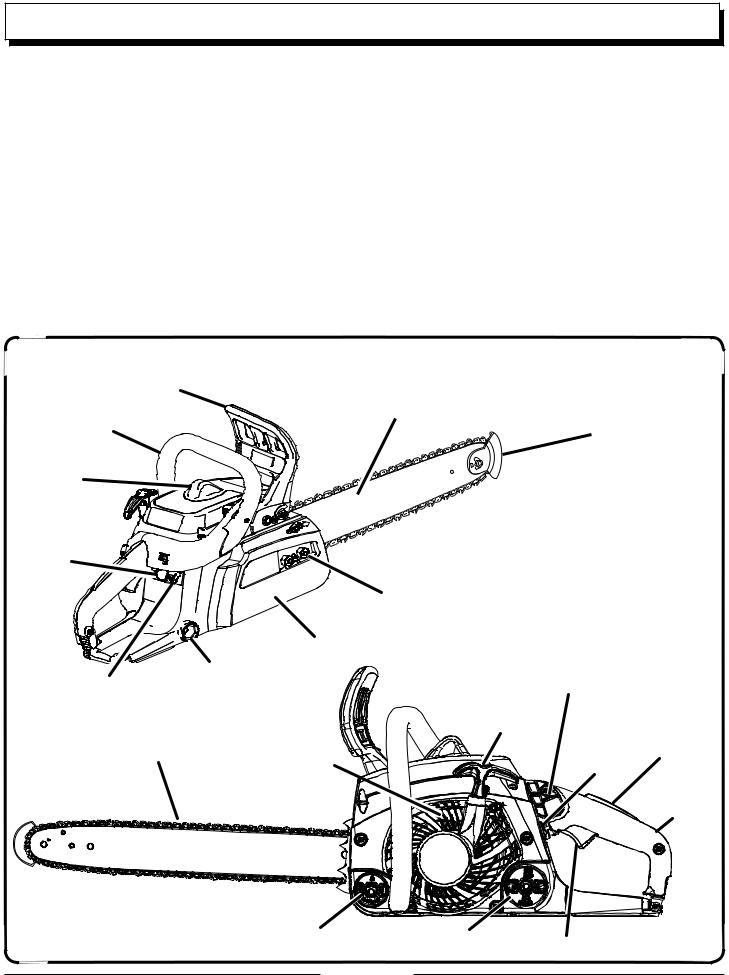
|
FEATURES |
PRODUCT SPECIFICATIONS |
|
Bar length ....................................................................................................................................................................... |
16 in. |
Chain pitch .................................................................................................................................................................. |
.375 in. |
Chain gauge ................................................................................................................................................................ |
.050 in. |
Chain type .................................................................................................................................... |
Low Profile Full Skip Tooth |
Chain drive links .................................................................................................................................................................. |
57 |
Drive sprocket ............................................................................................................................................................. |
6-tooth |
Engine displacement.................................................................................................................................... |
2.0 cu. in. (33cc) |
Engine power ....................................................................................................................................................... |
1.5 HP min. |
Idle engine speed ..................................................................................................................................... |
2,800 - 3,400 RPM |
Fuel tank capacity ...................................................................................................................................................... |
20.5 oz. |
Chain oil tank capacity ............................................................................................................................................... |
12.8 oz. |
Weight - No bar, chain, fuel or oil .............................................................................................................................. |
12.5 lbs. |
FRONT HAND |
|
GUARD/CHAIN |
|
BRAKE |
|
|
GUIDE BAR |
FRONT |
SAFE-T-TIP |
HANDLE |
ANTI-KICKBACK |
|
NOSE GUARD |
CYLINDER |
|
COVER |
|
PRIMER
BULB
|
|
|
BAR |
|
|
|
|
|
MOUNTING |
|
|
|
|
|
NUTS |
|
|
|
|
CLUTCH COVER |
|
|
|
CHOKE |
COMBINATION |
|
THROTTLE LOCK |
|
|
WRENCH |
|
|
|||
LEVER |
|
|
STARTER |
|
|
|
|
|
|
||
LOW KICKBACK |
|
GRIP |
TRIGGER |
||
STARTER/FAN |
IGNITION |
||||
|
SAW CHAIN |
RELEASE |
|||
|
|
HOUSING |
SWITCH |
|
|
|
|
|
|
REAR |
|
|
|
|
|
HANDLE |
|
CHAIN OIL |
FUEL CAP |
|
|
|
CAP |
THROTTLE TRIGGER |
Fig. 1 |
||
|
||||
|
|
|
||
|
Page 8 |
|
|
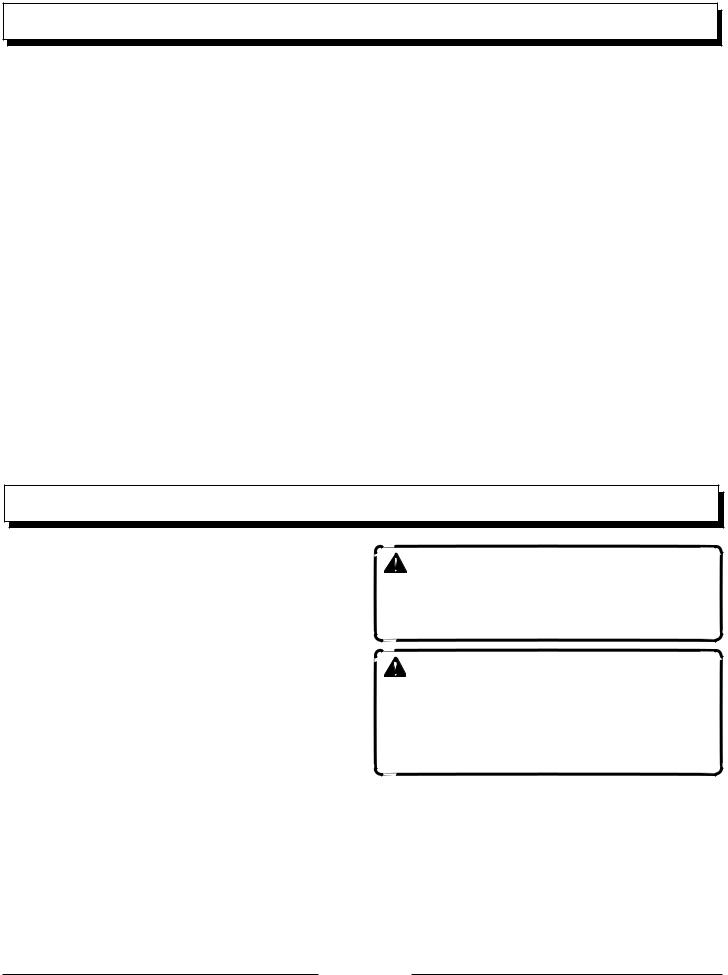
FEATURES
KNOW YOUR CHAIN SAW
See Figure 1.
Before attempting to use this product, familiarize yourself with all operating features and safety rules.
CHOKE LEVER
The choke lever opens and closes the choke valve in the carburetor. Positions available include FULL CHOKE, HALF CHOKE, and RUN.
COMBINATION WRENCH
A combination wrench tool is provided for use when performing various maintenance procedures. On-board storage keeps the tool handy at all times.
FRONT HAND GUARD / CHAIN BRAKE
The chain brake is designed to quickly stop the chain from rotating. When the front hand guard/chain brake is pushed toward the bar, the chain should stop immediately. The chain brake does not prevent kickback.
GUIDE BAR
The factory-equipped guide bar has a small radius tip that offers a somewhat lower kickback potential.
LOW KICKBACK SAW CHAIN
The low kickback saw chain helps minimize the force of a kickback reaction by preventing the cutters from digging in too deeply at the kickback zone.
PRIMER BULB
The primer bulb pumps fuel from the fuel tank to the carburetor.
SAFE-T-TIP ANTI-KICKBACK NOSE GUARD
The SAFE-T-TIP Anti-Kickback Nose Guard is an attachment provided on the end of the guide bar to prevent the chain on the end of the guide bar from contacting the wood.
THROTTLE LOCK
The throttle lock feature allows you to start the chain saw without having to continuously hold the throttle trigger.
THROTTLE TRIGGER
The throttle trigger is used for starting the chain saw, and also for controlling chain rotation.
ASSEMBLY
UNPACKING
This product has been shipped completely assembled.
Carefully remove the tool and any accessories from the box. Make sure that all items listed in the packing list are included.
Inspect the tool carefully to make sure no breakage or damage occurred during shipping.
Do not discard the packing material until you have carefully inspected and satisfactorily operated the tool.
If any parts are damaged or missing, please call 1-800-242-4672 for assistance.
PACKING LIST
Chain Saw
Scabbard
Combination Wrench
2-Cycle Engine Oil
Operator’s Manual
Case
WARNING:
If any parts are missing do not operate this tool until the missing parts are replaced. Failure to do so could result in possible serious personal injury.
WARNING:
Do not attempt to modify this tool or create accessories not recommended for use with this tool. Any such alteration or modification is misuse and could result in a hazardous condition leading to possible serious personal injury.
NOTE: The chain saw has been fully factory tested. It is normal to find some slight oil residue on the saw. Read and remove all hang tags and store with the Operator’s Manual.
Page 9

OPERATION
WARNING:
Do not allow familiarity with tools to make you careless. Remember that a careless fraction of a second is sufficient to inflict serious injury.
WARNING:
Always wear safety goggles or safety glasses with side shields when operating this tool. Failure to do so could result in objects being thrown into your eyes resulting in possible serious injury.
WARNING:
Do not use any attachments or accessories not recommended by the manufacturer of this tool. The use of attachments or accessories not recommended can result in serious personal injury.
APPLICATIONS
You may use this tool for the purposes listed below:
Basic limbing, felling, and woodcutting
Removing buttress roots
WARNING:
Always shut off engine before fueling. Never add fuel to a machine with a running or hot engine. Move at least 30 ft. from refueling site before starting the engine. DO NOT SMOKE! Failure to heed this warning can result in possible personal injury.
FUEL AND REFUELING
HANDLING THE FUEL SAFELY
WARNING:
Check for fuel leaks. If any are found, correct them before using the saw to prevent fire or burn injury.
Always handle fuel with care; it is highly flammable.
Always refuel outdoors and do not inhale fuel vapors.
Do not let gasoline or oil come in contact with skin.
Keep gasoline and oil away from the eyes. If gasoline or oil comes in contact with the eyes, wash them immediately with clean water. If irritation is still present, see a doctor immediately.
Clean up spilled fuel immediately.
Refer to Refueling in the Specific Safety Rules section of this manual for additional safety information.
MIXING THE FUEL
This product is powered by a 2-cycle engine and requires pre-mixing gasoline and 2-cycle oil. Pre-mix unleaded gasoline and 2-cycle engine oil in a clean container approved for gasoline.
This engine is certified to operate on unleaded gasoline intended for automotive use with an octane rating of 87 [(R + M) / 2] or higher.
Do not use any type of pre-mixed gasoline/oil from fuel service stations, this includes the pre-mixed gasoline/oil intended for use in mopeds, motorcycles, etc.
Use a high quality 2-cycle self-mixing oil for air-cooled engines. Do not use automotive oil or 2-cycle outboard oil.
Mix 2% oil into the gasoline. This is a 50:1 ratio.
Mix the fuel thoroughly and each time before fueling.
Mix in small quantities. Do not mix quantities larger than usable in a 30-day period. A 2-cycle oil containing a fuel stabilizer is recommended.
PREMIUM EXACT MIX™ (50:1)
GASOLINE |
OIL |
1 Gallon (US) |
2.6 oz. |
1 Liter |
20 cc (20 ml) |
Page 10
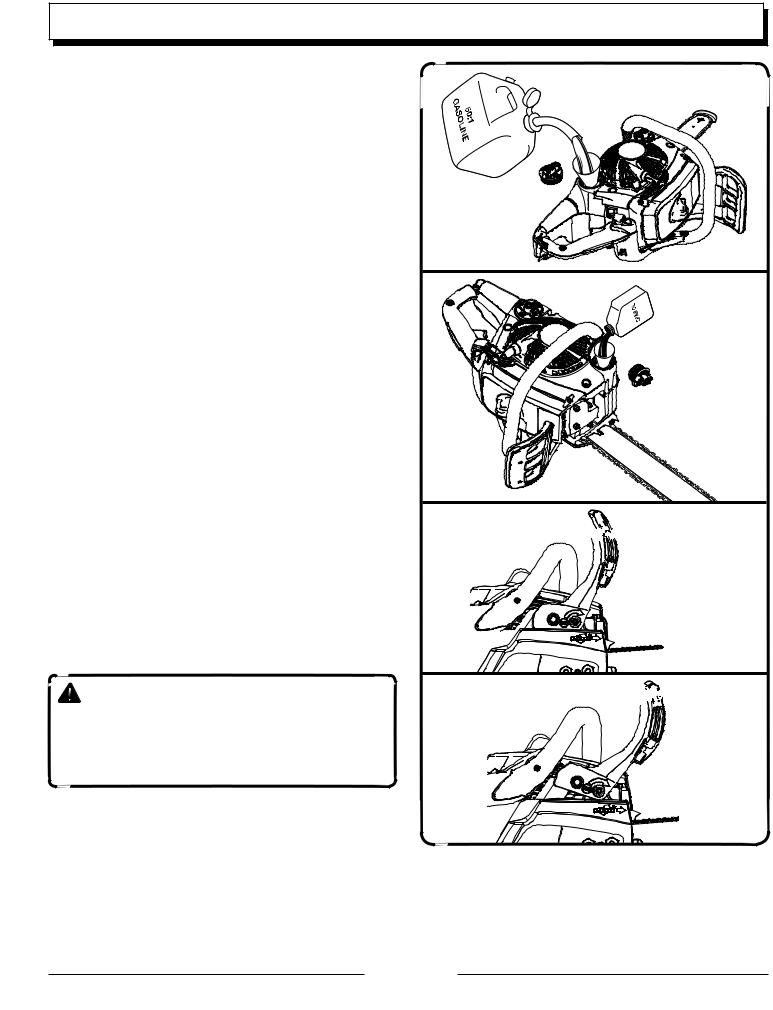
OPERATION
FILLING THE FUEL TANK
See Figure 2.
Clean the surface around the fuel cap to prevent contamination.
Loosen the fuel cap slowly.
Carefully pour the fuel mixture into the tank. Avoid spillage.
Prior to replacing the fuel cap, clean and inspect the o-ring.
Immediately replace the fuel cap and hand tighten. Wipe up any fuel spillage.
NOTE: It is normal for the engine to emit smoke during and after the first use.
ADDING BAR AND CHAIN OIL
See Figure 3.
Use HOMELITE Bar and Chain Oil. It is designed for chains and chain oilers, and is formulated to perform over a wide temperature range with no dilution required. Chain saw should use approximately one tank of oil per tank of fuel.
NOTE: Do not use dirty, used, or otherwise contaminated oils. Damage may occur to the oil pump, bar, or chain.
Carefully pour the bar and chain oil into the oil tank.
Fill the oil tank every time you fuel the engine.
OPERATING THE CHAIN BRAKE
See Figures 4 - 5.
Check the operating condition of the chain brake prior to each use.
Using the back of your left hand, engage the chain brake by pushing the chain brake lever/hand guard toward the bar while the chain is rotating rapidly.
Reset the chain brake back into the RUN position by grasping the top of the chain brake lever/hand guard and pulling toward the front handle until you hear a click.
WARNING:
If the chain brake does not stop the chain immediately, or if the chain brake will not stay in the run position without assistance, take the saw to an authorized service center for repair prior to use.
Fig. 2
Fig. 3













 RUN POSITION
RUN POSITION
Fig. 4
BRAKE POSITION























Fig. 5
Page 11
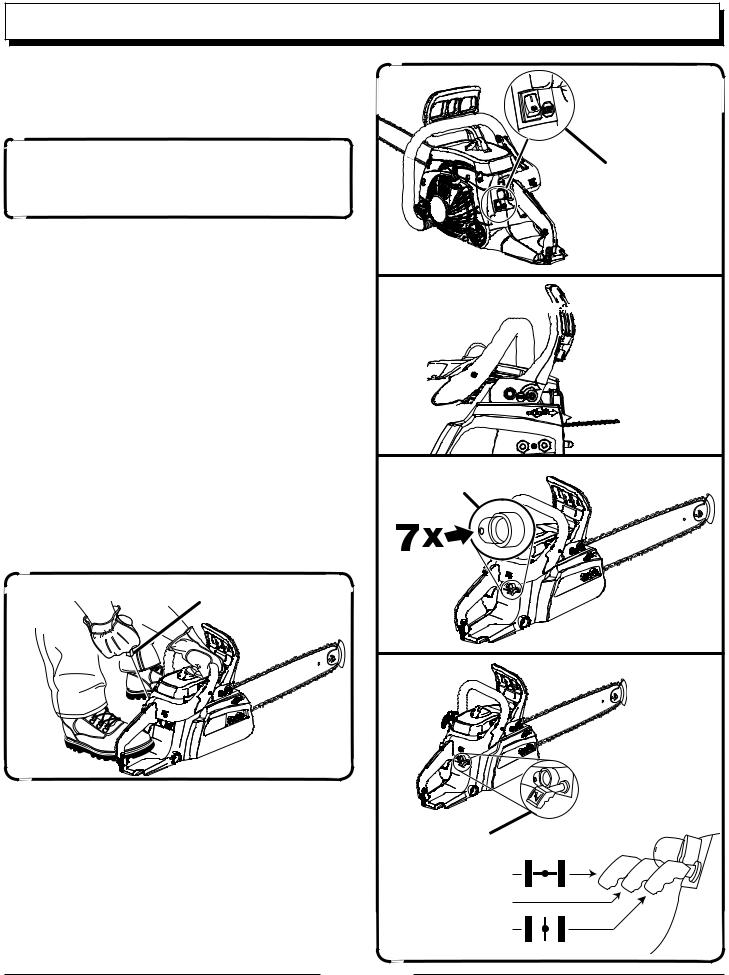
OPERATION
STARTING THE ENGINE
See Figures 6 - 11.
Starting the product differs depending on whether the engine is cold or warm.
 WARNING:
WARNING:
Keep your body to the left of the chain line. Never straddle the saw or chain, or lean over past the chain line.
Place the chain saw on level ground and ensure that no objects or obstructions are in the immediate vicinity that could come in contact with the bar and chain.
IGNITION SWITCH
IN THE RUN
POSITION
Fig. 7
Hold the front handle firmly with your left hand and put your right foot onto the base of the rear handle.
To Start a Cold Engine:
Set the ignition switch to the RUN ( I ) position.
Make sure the chain brake is in the run position by pulling back on the lever/hand guard.
Fully press and release the primer bulb 7 times.
Pull choke lever all the way out to FULL position.
While squeezing both the trigger release and throttle trigger, push in the throttle lock button. Release the throttle trigger. This latches the trigger for starting.
When the temperature is above 50° F, pull the starter grip until the engine attempts to start, but no more than 3 times. When the temperature is below 50° F, pull the starter grip until the engine attempts to start, but no more than 5 times.
STARTER
GRIP
Fig. 6










 RUN POSITION
RUN POSITION
Fig. 8
PRIMER BULB
Fig. 9
CHOKE LEVER
FULL CHOKE HALF CHOKE
RUN POSITION
Fig. 10
Page 12
